
Earl of Dunraven and Mount-Earl was a title in the Peerage of Ireland. It was created on 5 February 1822 for Valentine Quin, 1st Viscount Mount-Earl. Quin had already been created a Baronet, of Adare in County Limerick, in the Baronetage of Ireland, in 1781, Baron Adare, of Adare in the County of Limerick, on 31 July 1800, and Viscount Mount-Earl on 3 February 1816. He was made Viscount Adare in 1822 at the same time as he was given the earldom. The latter peerage titles were also in the Peerage of Ireland. The Quins were unusual among Irish landowning families in that era in being of Gaelic origin, although they married into Anglo-Irish families like the Widenhams of Kildimo and the Dawsons of Dublin.

Merthyr Mawr is a village and community in Bridgend, Wales. The village is about 2½ miles from the centre of Bridgend town. The population of the community at the 2011 census was 267. The community occupies the area west of the Ewenny River, between Bridgend and Porthcawl. It takes in the settlement of Tythegston and a stretch of coastal sand dunes known as Merthyr Mawr Warren. It is in the historic county of Glamorgan.

Margam Country Park is a country park estate in Wales, of around 850 acres (3.4 km²). It is situated in Margam, about 2 miles (3 km) from Port Talbot in south Wales. It was once owned by the Mansel Talbot family and is now owned and administered by the local council, Neath Port Talbot County Borough Council. Situated within the park are three notable buildings: Margam Abbey, a Cistercian monastery; Margam Castle, a neo-Gothic country house that was once the seat of the Mansel Talbot family; and the 18th-century Orangery. The park is designated Grade I on the Cadw/ICOMOS Register of Parks and Gardens of Special Historic Interest in Wales.

Colonel Windham Henry Wyndham-Quin, 5th Earl of Dunraven and Mount-Earl was an Irish Peer, British Army officer and a Conservative Member of Parliament for South Glamorganshire 1895–1906.

Windham Thomas Wyndham-Quin, 4th Earl of Dunraven and Mount-Earl,, styled Viscount Adare between 1850 and 1871, was an Anglo-Irish journalist, landowner, entrepreneur, sportsman and Conservative politician. He served as Under-Secretary of State for the Colonies under Lord Salisbury from 1885 to 1886 and 1886 to 1887. He also successfully presided over the 1902 Land Conference and was the founder of the Irish Reform Association. He recruited two regiments of sharpshooters, leading them in the Boer War and later establishing a unit in Ireland.

Edwin Richard Wyndham-Quin, 3rd Earl of Dunraven and Mount-EarlKP PC was an Irish peer, Member of Parliament, and archaeologist.

Windham Henry Quin, 2nd Earl of Dunraven and Mount-Earl was an Irish Peer.

Adare Manor is a manor house located on the banks of the River Maigue in the village of Adare, County Limerick, Ireland, the former seat of the Earl of Dunraven and Mount-Earl. The present house was built in the early 19th century, though retaining some of the walls of the 17th-century structure. It is now the Adare Manor Hotel & Golf Resort, a luxury hotel, and contains the Michelin-starred Oak Room restaurant.
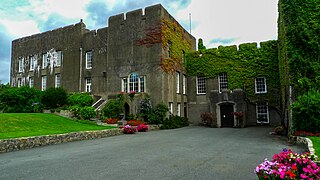
Fonmon Castle is a fortified medieval castle near the village of Fonmon in the Vale of Glamorgan and a Grade I listed building. The castle's gardens are designated Grade II on the Cadw/ICOMOS Register of Parks and Gardens of Special Historic Interest in Wales. With its origins rooted in the 12th century it is today seen as a great architectural rarity, as it is one of few buildings that was drastically remodelled in the 18th century, but not Gothicized. The castle is believed to have remained under the ownership of just two families throughout its history; from Norman times, it was owned by the St Johns, and from 1656, by the descendants of Colonel Philip Jones.
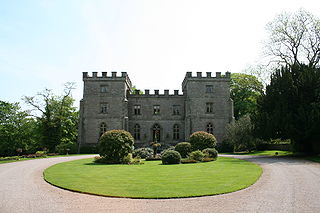
Clearwell Castle in Clearwell, the Forest of Dean, Gloucestershire, is a Gothic Revival house constructed from 1727. Built by Thomas Wyndham to the designs of Roger Morris, it is the earliest Georgian Gothic Revival castle in England predating better-known examples such as Strawberry Hill House by over twenty years. A home of the Wyndham family for some 150 years, the first half of the twentieth century saw a disastrous fire, and subsequent asset-stripping, which brought the castle close to ruination. Slowly restored from 1954, in the 1970s the castle housed a recording studio used by, among other major bands, Black Sabbath, Led Zeppelin, Deep Purple, Bad Company, Queen and Sweet. Now operating as a wedding venue, the castle is a Grade II* listed building.
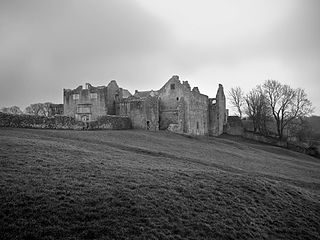
Old Beaupre Castle is a ruined medieval fortified manor house located in the community of Llanfair, outside Cowbridge in Wales. It is known in historic documents under the names Beawpire, Bewerpere, Bewpyr and Y Bewpur. It is a Grade I listed building and is under the care of Cadw. It can be visited free of charge all year round by members of the public. The gardens are designated Grade II on the Cadw/ICOMOS Register of Parks and Gardens of Special Historic Interest in Wales.
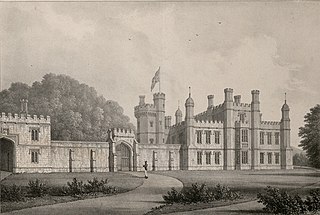
Halkyn Castle is a mansion house in the village of Halkyn, Flintshire, Wales. The house, with its associated stable block, is designated by Cadw as a Grade II* listed building.

Pwll-y-Wrach or Pwllywrach is a historic manor house to the east of Colwinston, Vale of Glamorgan, south Wales. The house and its Western garden house and Eastern garden house are all listed as Grade II listed buildings in their own right. The gardens themselves are designated Grade II on the Cadw/ICOMOS Register of Parks and Gardens of Special Historic Interest in Wales. The novelist Agatha Christie was a frequent visitor to the village and stayed at the house with her daughter Rosalind, son-in-law Hubert Prichard, and her only grandchild Mathew; her descendants, the Prichard family, still live at the former manor.

St Brides Major is a community on the western edge of the Vale of Glamorgan, South Wales. Its largest settlement is the village of St Brides Major, and also includes the villages of Ogmore-by-Sea and Southerndown, and the hamlets of Ogmore Village, Castle-upon-Alun, Heol-y-Mynydd, Norton and Pont-yr-Brown It is notable for coastal geology and scenery, limestone downlands and fossilised primitive mammals, sea cliffs and beaches, two Iron Age hillforts, three medieval castle sites,, two stepping stone river crossings and a clapper bridge. Three long distance paths cross the community. It is the western limit of the Vale of Glamorgan Heritage Coast, and has a visitor centre and tourist facilities.

Gyrn Castle is a Grade II-listed castellated mansion in Llanasa in Flintshire.
Llantrithyd is a rural village and community in the Vale of Glamorgan, Wales. The Aubrey Baronets were lords of the manor of Llantrithyd for centuries: the family died out in the 1850s.
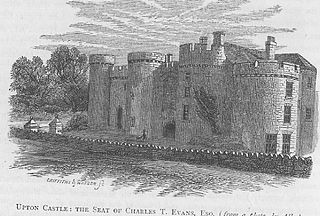
Upton Castle is a 13th-century castle or fortified manor house with an associated chapel, located near Cosheston, Pembrokeshire in Wales. Although in private ownership, the gardens are open to the public. They are listed on the Cadw/ICOMOS Register of Parks and Gardens of Special Historic Interest in Wales.

Tythegston is a conservation area village located close to Cardiff and Swansea on the south coast of Bridgend, Wales. It is home to Tythegston Court, a Grade II listed manor house at the centre of the 1,200 acre Tythegston Estate which is designated at Grade II on the Cadw/ICOMOS Register of Parks and Gardens of Special Historic Interest in Wales. The estate has been owned by the Knight family for some 350 years and operates as a farming and property enterprise, with an industrial estate, as well as hosting green energy and food production. The seaside town of Porthcawl, with its numerous beaches is within 3 miles, as is Bridgend inter-city rail station. The village covers an area of 2,871 acres (1,162 ha). It is part of the community of Merthyr Mawr.

Llanmihangel Place is a Grade I listed manor house in the Vale of Glamorgan, South Wales. It became a Grade I listed building on 16 December 1952. The house dates back to the 12th century, when it was constructed as a single-storey dwelling.

The Vale of Glamorgan is a county borough in south-east Wales. It covers an area of 331 km2 (128 sq mi) and in 2021 the population was approximately 132,500.




















